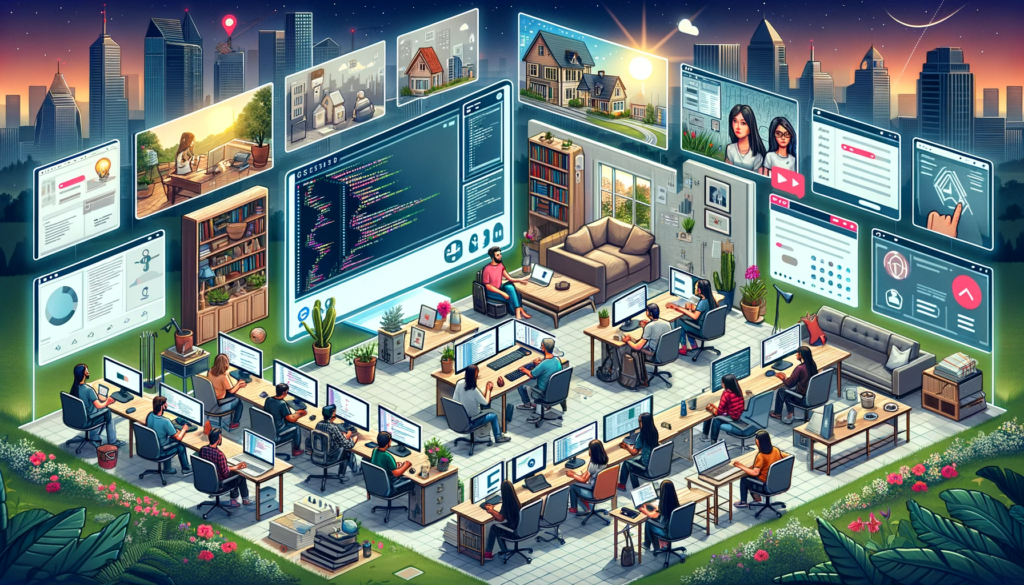Key Takeaways
- Effective communication strategies for remote software development teams.
- Best practices for managing remote development projects.
- Tools and technologies that enhance remote collaboration.
- Strategies for maintaining productivity in a remote environment.
- Techniques for fostering team cohesion and morale remotely.
- Importance of clear documentation in remote software development.
- Challenges of remote work and how to overcome them.
- Benefits of remote software development for businesses and developers.

In today’s fast-evolving tech landscape, remote software development has become a staple for many companies and developers. The shift from traditional office-based work to remote environments presents unique challenges and opportunities for streamlining processes. This comprehensive guide delves into effective strategies, tools, and best practices for optimizing remote software development, ensuring productivity, and maintaining team cohesion.
Communication: The Backbone of Remote Development
Effective communication is crucial in remote software development. It’s the glue that holds distributed teams together and ensures smooth project progression. But how do you maintain clear, consistent, and effective communication across different time zones and workspaces?
Choosing the Right Communication Tools
Selecting appropriate communication tools is the first step. Tools like Slack, Microsoft Teams, and Discord offer real-time messaging, while Zoom and Google Meet are excellent for video conferencing. The key is to choose platforms that best fit your team’s needs, considering factors like user-friendliness, integration capabilities, and security features.
Establishing Communication Protocols
Once tools are in place, establishing clear communication protocols is essential. This includes defining when and how often to hold meetings, setting expectations for response times, and determining the preferred medium for different types of communication (e.g., email for formal communications, instant messaging for quick queries).
Project Management in a Remote Setting
Managing a project remotely requires a different approach compared to traditional settings. The absence of physical presence means relying more on digital tools and proactive management techniques.
Utilizing Project Management Software
Project management software like Jira, Trello, or Asana helps in organizing tasks, tracking progress, and maintaining transparency. These tools allow for assigning tasks, setting deadlines, and monitoring development stages, ensuring everyone is on the same page.
Agile Methodology and Remote Work
Agile methodologies, particularly Scrum and Kanban, are well-suited for remote development environments. They promote flexibility, regular check-ins, and adaptive planning, which are critical in a remote setting. Implementing sprint planning, daily stand-ups, and retrospectives can significantly enhance project management in a remote context.
Technology Stack for Remote Development
The right technology stack is pivotal for streamlined remote development. This encompasses not just development tools, but also collaboration and monitoring software.
Development and Collaboration Tools
IDEs (Integrated Development Environments) like Visual Studio Code or JetBrains suite, along with version control systems such as Git, are fundamental. For real-time collaboration, tools like GitHub and GitLab offer excellent features for code review and collaborative coding.
Cloud Services and DevOps
Cloud services like AWS, Azure, or Google Cloud provide remote teams with scalable and accessible platforms for development and deployment. Incorporating DevOps practices and tools can further streamline the development process, enhancing collaboration and efficiency.
Maintaining Productivity in a Remote Environment
Productivity in a remote setting hinges on more than just individual discipline. It involves creating an environment and culture that supports focused and efficient work.
Setting Up a Productive Workspace
Encourage team members to set up dedicated workspaces free from distractions. Investing in ergonomic furniture and quality hardware can also boost productivity and comfort.
Time Management and Flexibility
Implementing time management techniques like the Pomodoro Technique or time blocking can help in maintaining focus. Flexibility in work hours, considering different time zones and personal preferences, can also lead to increased productivity and job satisfaction.

Building and Sustaining Team Cohesion Remotely
Fostering team spirit and cohesion is challenging yet crucial in a remote setup. It’s about creating a sense of belonging and shared purpose, even when physically apart.
Regular Virtual Team Building Activities
Organize regular virtual team-building activities like online games, casual meetups, or skill-sharing sessions. These activities can bridge the physical gap and build camaraderie among team members.
Encouraging Open and Inclusive Culture
Creating an environment where team members feel comfortable sharing ideas and feedback is vital. Regular check-ins, both work-related and personal, can help in understanding team dynamics and addressing any issues promptly.
Emphasizing Clear Documentation
In a remote software development environment, clear and comprehensive documentation becomes more important than ever. It serves as a reference point and ensures continuity in projects, especially when team members work across different time zones.
Importance of Comprehensive Documentation
Good documentation covers everything from project requirements to coding standards and from deployment processes to emergency protocols. It should be detailed enough for any new team member to understand the project’s workflow and existing codebase without extensive hand-holding.
Best Practices for Documentation
Adopting a consistent format and maintaining up-to-date documentation is crucial. Tools like Confluence, Notion, or GitHub Wikis can be used to create and store documentation. Encourage team members to contribute to and regularly update documentation, making it a living document that evolves with the project.
Overcoming Remote Work Challenges
While remote work offers flexibility and access to a global talent pool, it comes with its own set of challenges that need to be addressed to ensure a smooth workflow.
Handling Time Zone Differences
One major challenge is managing time zone differences. To tackle this, teams can establish overlapping hours where all members are available for meetings or collaboration. Utilizing asynchronous communication methods effectively also helps in mitigating the time zone impact.
Dealing with Isolation and Burnout
Remote work can sometimes lead to feelings of isolation or burnout. Regular one-on-one check-ins, promoting a healthy work-life balance, and providing mental health support are essential in addressing these issues. Encouraging breaks and time off and respecting non-working hours are also vital practices.

Leveraging the Benefits for Businesses and Developers
Remote software development offers several benefits for both businesses and developers, which can be maximized with the right approach.
Access to Global Talent and Cost Efficiency
Businesses can access a wider talent pool without geographical constraints, often at a more cost-effective rate. This diversity can bring in fresh perspectives and innovative solutions to projects.
Flexibility and Increased Job Satisfaction
For developers, remote work offers flexibility in choosing their work environment and schedule, which can lead to higher job satisfaction and productivity. It also opens opportunities to work with international teams and projects, broadening their professional exposure.
Implementing Effective Security Measures
In remote setups, ensuring the security of code and data is paramount. This involves both technical measures and fostering a culture of security awareness.
Securing Remote Connections
Using VPNs (Virtual Private Networks), implementing multi-factor authentication, and ensuring secure internet connections are basic steps. Regular security training and awareness programs can help team members stay updated on best practices and potential threats.
Data Protection and Privacy Policies
It’s important to have clear data protection and privacy policies in place, especially when dealing with sensitive client information. Regular audits and compliance checks can help in maintaining high security standards.
Incorporating Continuous Learning and Development
The tech industry is constantly evolving, and so should the skills of a remote development team. Continuous learning and professional development are key to keeping the team updated and motivated.
Providing Learning Resources and Opportunities
Offering access to online courses, webinars, and workshops can help team members stay abreast of the latest technologies and methodologies. Encouraging knowledge sharing sessions within the team can also be beneficial.
Setting Up Mentorship and Peer Review Systems
Implementing mentorship programs and peer review systems can facilitate skill transfer and foster a culture of continuous improvement. This not only enhances the team’s capabilities but also boosts morale and team cohesion.
Advanced Project Management Techniques in Remote Development
Efficient project management in remote software development requires more than just the right tools; it involves adopting advanced techniques that cater to the unique challenges of a distributed team.
Implementing Hybrid Agile-Scrum Methodologies
Combining Agile with Scrum methodologies provides a flexible yet structured approach to project management. In a remote setting, this hybrid model can be adapted to include shorter sprints, more frequent check-ins, and digital scrum boards to track progress.
Utilizing Predictive Analytics for Project Planning
Predictive analytics can be used to forecast project timelines, potential bottlenecks, and resource allocation needs. Tools like JIRA’s advanced roadmaps or similar project management software can offer insights based on historical data, improving planning accuracy and efficiency.
Embracing Asynchronous Workflows
Given the time zone differences in remote teams, embracing asynchronous workflows is essential. This involves setting clear expectations about turnaround times for tasks and allowing team members to work on their schedules as long as deadlines and quality standards are met.
Maintaining Client Relationships Remotely
Building and sustaining strong client relationships is crucial for the success of remote software development projects. This requires deliberate strategies and practices tailored to remote interactions.
Regular and Transparent Client Communication
Regular updates, transparent communication about project status, and prompt responses to client queries are key. This could mean weekly status reports, monthly video calls, or real-time access to project management tools, depending on the client’s preference.
Utilizing CRM Tools for Better Relationship Management
Customer Relationship Management (CRM) tools can help in organizing client information, tracking communication history, and scheduling follow-ups. This ensures no client feels neglected and that all interactions are personalized and informed.
Hosting Virtual Client Workshops
Hosting virtual workshops or presentations can be an effective way to engage clients and involve them in the development process. These sessions can be used to gather feedback, discuss project roadmaps, or even provide training on new features or products.

The Future of Remote Work in Software Development
As remote work becomes increasingly prevalent in the software industry, understanding its future trajectory and preparing for upcoming trends is vital for any organization or developer.
Embracing a Global Talent Pool
The future of remote work lies in leveraging the global talent pool, transcending geographical limitations. This will not only bring in diverse perspectives but also allow businesses to operate virtually 24/7 by having teams in different time zones.
Advancements in Remote Collaboration Technologies
Technological advancements, such as augmented reality (AR) and virtual reality (VR), are set to revolutionize remote collaboration. These technologies could create virtual workspaces that mimic physical offices, allowing for more interactive and immersive remote working experiences.
Preparing for an Increase in Remote Work Policies
With the proven effectiveness of remote work, more companies are likely to adopt permanent remote or hybrid work policies. This shift will require ongoing adaptation of management practices, communication strategies, and team dynamics.
Enhancing Remote Team Well-being and Mental Health
The well-being and mental health of remote teams are crucial for sustained productivity and job satisfaction. Developing strategies to support these aspects is a key responsibility of remote team leaders.
Promoting Work-Life Balance
Encouraging a healthy work-life balance is essential. This can include setting boundaries to prevent overwork, respecting off-hours, and providing flexibility for personal needs and family time.
Mental Health Support and Resources
Providing access to mental health resources, such as counseling services or wellness programs, can be beneficial. Regular check-ins and creating an environment where team members feel comfortable discussing their mental health are also important.
Organizing Virtual Social Events
Virtual social events and activities can help in reducing feelings of isolation and building team camaraderie. This could range from casual coffee chats to more organized events like virtual team-building exercises or online game nights.
Streamlining Code Review and Quality Assurance
In remote software development, ensuring high-quality code and robust quality assurance (QA) processes are more challenging yet crucial. Streamlining these processes is key to maintaining product standards and reducing time to market.
Adopting Automated Testing Tools
Automated testing tools can significantly enhance the efficiency of the QA process. Tools like Selenium for web applications or Appium for mobile applications allow for continuous testing, catching bugs early in the development cycle.
Implementing Peer Review Processes
Peer code reviews are essential for maintaining code quality and facilitating knowledge sharing among team members. Platforms like GitHub or Bitbucket provide integrated tools for conducting code reviews and facilitating discussions.
Regular Performance Auditing
Conducting regular performance audits of both the development process and the end products ensures continuous improvement. This involves analyzing key performance indicators (KPIs) and implementing changes based on the insights gained.
Handling Security in a Distributed Environment
Security in a remote software development setting is paramount, given the dispersed nature of teams and the use of various networks. A robust security strategy is essential to protect sensitive data and maintain client trust.
Establishing Strict Access Controls
Implementing strict access controls is vital. This includes using role-based access controls (RBAC) to ensure that team members have access only to the resources necessary for their role. Tools like AWS Identity and Access Management (IAM) or Azure Active Directory provide robust solutions for managing access.
Enhancing Network Security
Securing the network is another critical aspect. This involves using Virtual Private Networks (VPNs) for secure connections and ensuring that home networks of team members are protected with adequate firewalls and anti-virus software. Regular security audits and penetration testing can also help identify and address vulnerabilities.
Conducting Regular Security Training
Regular training sessions on security best practices are essential. This should cover topics like phishing, secure coding practices, and data handling protocols. Encouraging a culture of security mindfulness helps in maintaining a high level of vigilance among team members.

Optimizing Remote User Experience Design
In remote software development, ensuring an optimal user experience (UX) can be challenging due to the lack of direct user interaction. However, there are strategies to effectively manage and optimize UX design remotely.
Utilizing Collaborative Design Tools
Tools like Figma, Sketch, and InVision facilitate collaborative UX/UI design, allowing multiple designers to work on the same project simultaneously. These tools offer real-time feedback capabilities and version control, streamlining the design process.
Conducting Remote User Testing
Remote user testing is essential for gathering user feedback. This can be achieved through online surveys, video call interviews, or using platforms like UserTesting.com. Analyzing user behavior through heatmaps and analytics tools like Hotjar or Google Analytics also provides valuable insights.
Emphasizing Accessibility and Inclusivity
Accessibility and inclusivity should be key considerations in UX design. Ensuring that the software is usable and accessible to people with disabilities is not only a legal requirement in many jurisdictions but also expands the potential user base.
Leveraging Cloud Technologies for Efficiency
Cloud technologies play a pivotal role in enhancing the efficiency and scalability of remote software development processes.
Benefits of Cloud Computing
Cloud computing offers scalability, flexibility, and cost-efficiency. It allows teams to quickly spin up development environments, scale resources as per demand, and pay only for what they use. This is particularly beneficial for startups and small teams.
Implementing Continuous Integration and Deployment (CI/CD)
Adopting a CI/CD pipeline, using services like Jenkins, CircleCI, or GitHub Actions, enables teams to automate the testing and deployment process. This leads to faster release cycles, higher quality software, and more efficient use of resources.
Utilizing Cloud-Based Development Environments
Cloud-based development environments, such as AWS Cloud9 or Microsoft Visual Studio Codespaces, allow developers to write, run, and debug code directly in the cloud. This ensures a consistent development environment across the team and reduces the time spent on setting up local environments.
Advanced Analytics and Data Management in Remote Development
Data is a crucial asset in software development, and managing it effectively in a remote setting is essential for informed decision-making and maintaining competitiveness.
Implementing Data Analytics Tools
Using advanced data analytics tools like Google Analytics, Tableau, or Power BI helps in deriving actionable insights from large datasets. These tools can be used to track user engagement, monitor application performance, and inform product development decisions.
Embracing Big Data Technologies
For projects involving large-scale data processing, technologies like Hadoop, Spark, or cloud-based solutions like Google BigQuery are vital. They enable the processing of large datasets efficiently, which is essential for applications like machine learning or real-time analytics.
Ensuring Data Compliance and Privacy
Adhering to data privacy regulations such as GDPR or HIPAA is critical, especially when dealing with sensitive user data. Implementing data governance policies and practices that ensure compliance and protect user privacy is a must for any remote software development team.
Remote Resource Management and Optimization
Resource management in a remote software development context involves not just managing the team, but also efficiently utilizing the technological resources at disposal.
Effective Resource Allocation
Proper allocation of resources, be it human resources or technological assets, is crucial for the success of a project. This involves assessing the skills and capabilities of team members and assigning tasks accordingly, as well as ensuring that the necessary technological resources are available and optimally used.
Tools for Resource Tracking and Management
Using project management and resource tracking tools like Jira, Monday.com, or Teamwork, helps in monitoring resource allocation, tracking time spent on tasks, and managing workloads. These tools provide visibility into team productivity and resource utilization, aiding in making informed management decisions.
Strategies for Cost Optimization
Cost optimization, especially in terms of cloud resources, is vital. Techniques like using reserved instances, automating resource scaling, and monitoring usage with tools like Cloud
Watch or Azure Monitor can significantly reduce costs while maintaining performance.
Table: Comparison of Key Remote Software Development Tools
| Feature/Tool | Slack | Trello | GitHub | Zoom | AWS |
|---|---|---|---|---|---|
| Primary Use | Communication | Project Management | Version Control | Video Conferencing | Cloud Services |
| Real-Time Collaboration | Yes | Yes | Yes | Yes | Varies |
| Integration Capabilities | Extensive | Moderate | Extensive | Moderate | Extensive |
| Security Features | High | High | Very High | High | Very High |
| User-Friendliness | High | High | Moderate | High | Moderate |
| Mobile Accessibility | Excellent | Excellent | Good | Excellent | Good |
| Cost (Basic Plan) | Free/$6.67 user/month | Free/$9.99 user/month | Free/$7 user/month | Free/$14.99 user/month | Pay-as-you-go |
Note: The costs are indicative and may vary based on specific plans and features.
Conclusion
Streamlining remote software development processes is critical in today’s globalized and digitally connected world. This comprehensive guide has highlighted the key areas that remote teams need to focus on to ensure efficient and productive operations.
From establishing effective communication protocols and leveraging the right project management techniques to ensuring robust security measures and fostering a healthy remote work culture, these strategies are vital for success in the remote software development realm.
By embracing the right tools, methodologies, and practices, remote teams can overcome the unique challenges they face and capitalize on the myriad benefits that remote work offers.
Frequently Asked Questions
How do you ensure effective communication in a remote software development team?
Effective communication in a remote team can be ensured by choosing the right tools like Slack or Microsoft Teams for instant messaging, and Zoom or Google Meet for video conferencing. Establish clear communication protocols, including regular meeting schedules, and use asynchronous communication effectively.
What are the best practices for remote project management?
Best practices include using project management software like Jira or Trello, adopting Agile methodologies, and embracing asynchronous workflows. Regular check-ins and transparency in task management and progress tracking are also crucial.
How can remote software development teams maintain high security?
Maintain high security by implementing strict access controls, enhancing network security through VPNs and firewalls, and conducting regular security training. Ensure all team members are aware of best practices for data handling and security protocols.
What strategies can be used to optimize user experience design remotely?
Optimizing UX design remotely can be achieved through collaborative tools like Figma or InVision, conducting remote user testing, and emphasizing accessibility and inclusivity in design. Regular feedback and iteration based on user data are essential.
How can remote development teams foster innovation?
Innovation can be fostered by encouraging a culture of continuous learning, promoting open communication for idea sharing, and organizing regular brainstorming sessions. Implementing hackathons and innovation challenges can also spur creativity.
What are some effective ways to manage resources in remote software development?
Effective resource management includes proper allocation of tasks based on team skills, using tools for resource tracking and workload management, and strategies for cost optimization, especially in cloud resource usage.
Can remote software development be as productive as in-office work?
Yes, remote software development can be equally, if not more, productive than in-office work. This requires a disciplined approach to work, effective use of collaborative tools, and a strong focus on communication and project management practices.
How do you handle time zone differences in a global remote team?
Handle time zone differences by establishing overlapping hours for real-time collaboration, utilizing asynchronous communication methods, and scheduling meetings at mutually convenient times. Flexibility and clear communication are key.